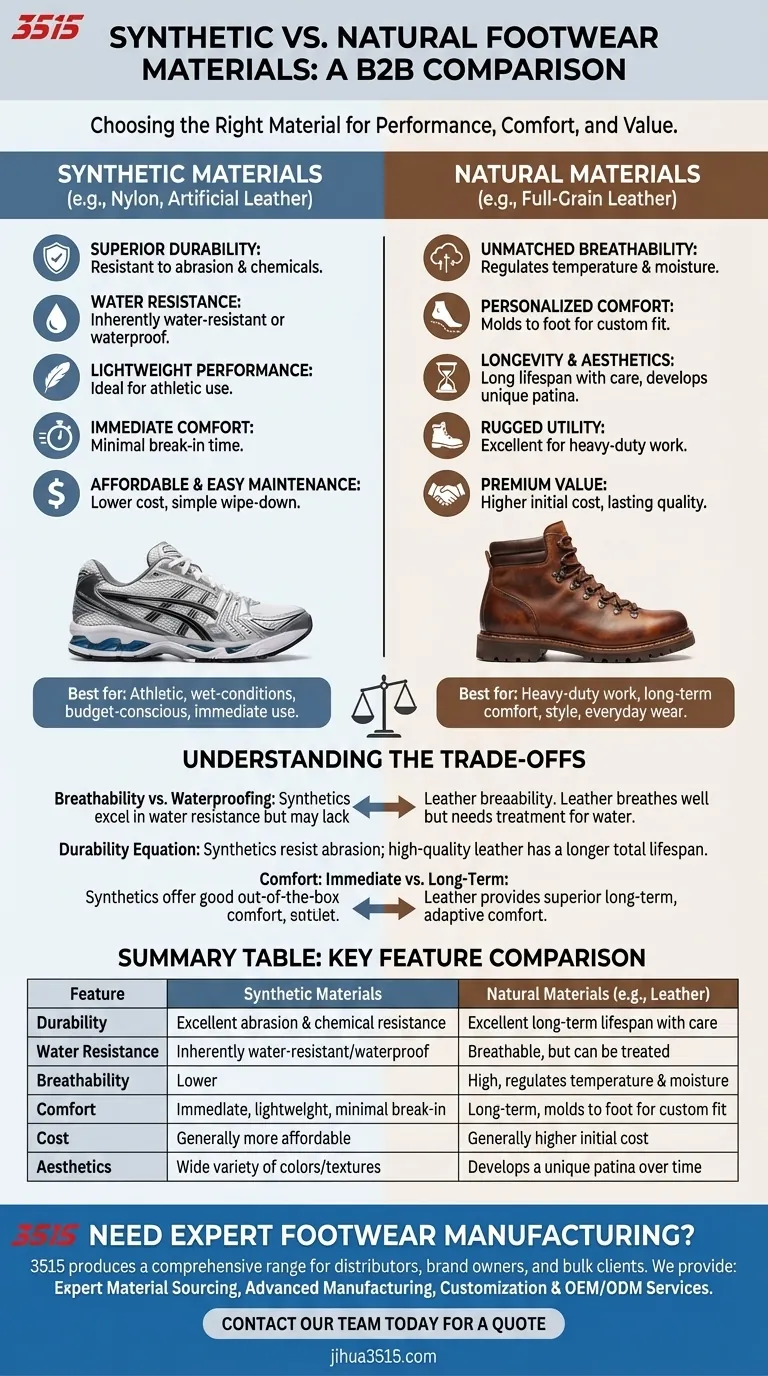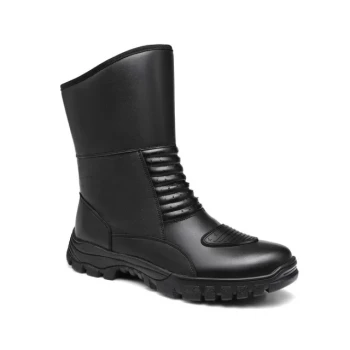In footwear, synthetic materials primarily offer superior durability, water resistance, and affordability at the point of purchase. In contrast, natural materials like leather excel in breathability, the ability to mold to your foot for personalized comfort over time, and developing a unique aesthetic character.
The choice between synthetic and natural footwear is not about which is universally "better," but which material's specific strengths—be it the immediate, rugged utility of synthetics or the long-term, adaptive comfort of natural leather—best align with your intended use, budget, and performance priorities.

The Case for Synthetic Materials
Modern synthetics have evolved far beyond their low-quality origins. They are engineered materials designed to provide specific performance advantages, often mimicking natural materials while adding new capabilities.
Durability and Resistance
Synthetic materials like nylon and artificial leather are highly resistant to abrasion and certain chemicals. This makes them exceptionally durable for specific, demanding environments.
Their non-porous nature also makes them inherently water-resistant or fully waterproof, a crucial feature for outdoor and athletic footwear.
Performance and Versatility
Synthetics are typically much more lightweight than natural leather, which is a significant advantage in sports shoes where every ounce matters.
They require less break-in time than stiff leather, offering more immediate comfort out of the box. Manufacturers can also produce synthetics in a vast range of colors and textures, offering wide design flexibility.
Cost and Maintenance
Generally, footwear made from synthetic materials is more affordable than its natural counterpart. They are also very easy to clean and maintain, often requiring just a simple wipe-down.
The Enduring Appeal of Natural Materials
Natural materials, most commonly leather, have been used in footwear for centuries for good reason. Their unique properties offer a different kind of performance and value.
Unmatched Breathability
Leather is a naturally porous material, which allows it to breathe. This is critical for regulating temperature and moisture, reducing sweat and increasing comfort during long periods of wear.
Personalized Comfort
The most prized quality of full-grain leather is its ability to mold to the wearer's foot over time. This creates a truly custom fit that synthetic materials cannot replicate, leading to exceptional long-term comfort.
Longevity and Aesthetics
High-quality leather is incredibly rugged and, with proper care, can last significantly longer than most synthetics.
It also develops a unique patina—a rich sheen and character that comes with age and use. This aesthetic appeal is highly valued and cannot be duplicated by artificial materials.
Understanding the Trade-offs
Neither material type is perfect for every situation. The best choice depends on a clear understanding of their inherent compromises.
The Breathability vs. Waterproofing Dilemma
The excellent water resistance of synthetics often comes at the cost of breathability. This can lead to hot, sweaty feet in warm conditions. Conversely, leather's natural breathability makes it more susceptible to water unless specifically treated.
The Durability Equation
While synthetics resist abrasion well, high-quality full-grain leather often has a longer total lifespan. Synthetic materials can become brittle or break down over time, whereas leather can be conditioned and maintained for decades.
Comfort: Immediate vs. Long-Term
Synthetics provide good out-of-the-box comfort with minimal break-in. However, leather provides superior long-term, adaptive comfort as it conforms perfectly to the unique shape of your foot.
Making the Right Choice for Your Goal
Your primary use case should dictate your choice of material.
- If your primary focus is athletic performance or wet-conditions: Choose synthetics for their lightweight, water-resistant, and immediately comfortable design.
- If your primary focus is heavy-duty work and long-term durability: Choose full-grain leather for its ruggedness and ability to mold to your foot for all-day support.
- If your primary focus is everyday comfort and style: Both are valid, but leather offers superior breathability and a classic aesthetic that improves with age.
- If your primary focus is budget and easy maintenance: Synthetics provide the best value and are simplest to care for.
Ultimately, understanding these core material properties empowers you to select footwear that truly serves its intended purpose.
Summary Table:
| Feature | Synthetic Materials | Natural Materials (e.g., Leather) |
|---|---|---|
| Durability | Excellent abrasion & chemical resistance | Excellent long-term lifespan with care |
| Water Resistance | Inherently water-resistant/waterproof | Breathable, but can be treated |
| Breathability | Lower | High, regulates temperature & moisture |
| Comfort | Immediate, lightweight, minimal break-in | Long-term, molds to foot for custom fit |
| Cost | Generally more affordable | Generally higher initial cost |
| Aesthetics | Wide variety of colors/textures | Develops a unique patina over time |
Need Expert Footwear Manufacturing?
As a large-scale manufacturer, 3515 produces a comprehensive range of footwear for distributors, brand owners, and bulk clients. Our production capabilities encompass all types of shoes and boots, whether you require the high-performance advantages of modern synthetics or the timeless quality of premium leathers.
We provide:
- Expert Material Sourcing: We help you select the ideal materials for your target market and application.
- Advanced Manufacturing: State-of-the-art facilities ensuring quality, consistency, and scalability.
- Customization & OEM/ODM Services: From design to delivery, we bring your unique footwear vision to life.
Let's discuss your next project. Contact our team today to get a quote and learn how we can be your trusted manufacturing partner.
Visual Guide

Related Products
- Safety Footwear Wholesale Manufacturer for Custom OEM/ODM Production
- Premium KPU Injection Athletic Style Safety Shoes
- Wholesale Safety Footwear Manufacturer for Bulk & Custom OEM Orders
- Wholesale Durable Breathable Safety Boots Custom OEM Manufacturer
- Wholesale Leather Safety Boots with Customizable Protective Toe
People Also Ask
- How long can you wear safety boots? The Lifespan is Determined by Wear, Not Time
- What are the differences between steel toe, composite toe, and alloy toe Wellington boots? Choose the Right Safety Toe for Your Job
- What cultural and environmental considerations are tied to wearing shoes indoors? Balance Hygiene, Tradition, and Foot Health
- Do snake bite boots work? Your Ultimate Guide to Effective Snake Bite Protection
- What do heavy duty boots do? Protect Your Feet in Demanding Work Environments



















